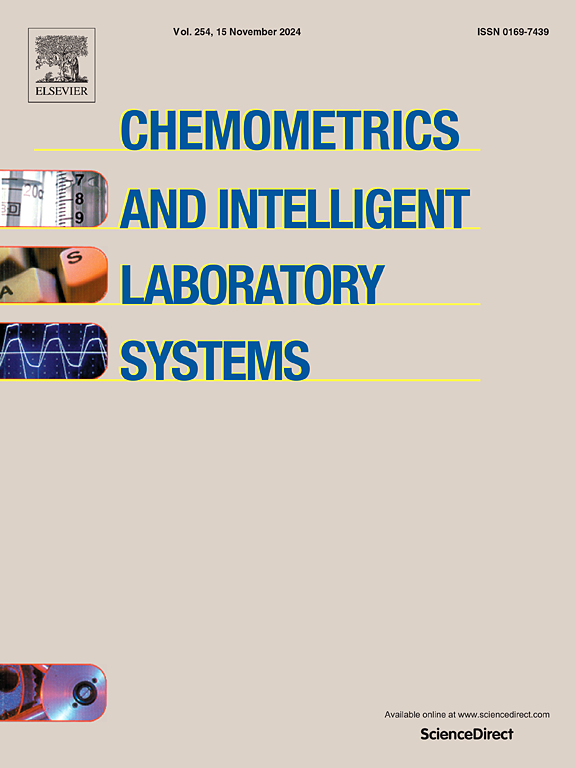改进的基于PLS子空间的多光谱仪校准转移方法,使用小型标准化样品集
IF 3.8
2区 化学
Q2 AUTOMATION & CONTROL SYSTEMS
Chemometrics and Intelligent Laboratory Systems
Pub Date : 2025-10-03
DOI:10.1016/j.chemolab.2025.105545
引用次数: 0
摘要
近红外光谱(NIRS)校准转移在不同制造商的多台仪器上部署模型时面临重大挑战,特别是因为固有的低摩尔吸收率使得光谱数据对光学设置的微小变化高度敏感。本研究提出了在PLS潜变量空间内运行的两种增强的校准传递方法(ICTWM1和ICTWM2),利用降维来保留分析相关方差,同时降低噪声干扰。ICTWM1采用谱空间变换(spectral space transformation, SST)对不同仪器间PLS成分得分进行校正,而ICTWM2则对变异性最高的主成分回归系数进行选择性校正。使用小麦蛋白分析(来自A和B制造商的7台二级仪器)和工业甘蔗糖度测定(分布在不同地理位置的8台二级仪器)对方法进行了验证。ICTWM1表现出优异的性能,与仅使用小麦数据集上10个标准化样本的主要工具模型相比,其相对性能达到79.3%,与传统方法相比,其跨工具一致性(标准偏差为6.9%)有所提高(> 15%)。该方法没有表现出与制造商相关的性能偏差,并且在从10到110的样本量范围内保持一致的性能。在只有5个训练样本的严格约束甘蔗数据集下,ICTWM1和ICTWM2均取得了较好的性能,RMSEP均值分别为0.14°Bx和0.15°Bx,优于传统的校准转移方法。ICTWM1通过优化PLS子空间内的变换,提高了样本效率和跨厂商鲁棒性。这些特性使其成为工业近红外光谱应用的实用方法,需要用最小的标准化样品进行可靠的校准转移。本文章由计算机程序翻译,如有差异,请以英文原文为准。
Enhanced PLS subspace-based calibration transfer method for multiple spectrometers using small standardization sample sets
Near-infrared spectroscopy (NIRS) calibration transfer faces significant challenges when deploying models across multiple instruments from different manufacturers, particularly because the inherently low molar absorptivity makes spectral data highly sensitive to minor variations in optical setup. This study presents two enhanced calibration transfer methods (ICTWM1 and ICTWM2) operating within the PLS latent variable space, utilizing dimensionality reduction to preserve analytically relevant variance while reducing noise interference. ICTWM1 employs spectral space transformation (SST) to correct PLS component scores between different instruments, while ICTWM2 selectively corrects the regression coefficients of the principal components with the highest variability.
The methods were validated using wheat protein analysis (7 secondary instruments from manufacturers A and B) and industrial sugarcane Brix determination (8 secondary instruments across geographically distributed facilities). ICTWM1 demonstrated superior performance, achieving 79.3 % relative performance compared to the primary instrument model using only 10 standardization samples on the wheat dataset, with improved cross-instrument consistency (standard deviations of 6.9 %) compared to traditional methods (>15 %). The method exhibited no manufacturer-dependent performance bias and maintained consistent performance across sample sizes ranging from 10 to 110. Under severely constrained sugarcane dataset with only 5 training samples, both ICTWM1 and ICTWM2 achieved good performance with mean RMSEP values of 0.14°Bx and 0.15°Bx, respectively, outperforming traditional calibration transfer methods.
ICTWM1 demonstrates improved sample efficiency and cross-manufacturer robustness through optimized transformation within PLS subspace. These characteristics make it a practical method for industrial NIRS applications requiring reliable calibration transfer with minimal standardization samples.
求助全文
通过发布文献求助,成功后即可免费获取论文全文。
去求助
来源期刊
CiteScore
7.50
自引率
7.70%
发文量
169
审稿时长
3.4 months
期刊介绍:
Chemometrics and Intelligent Laboratory Systems publishes original research papers, short communications, reviews, tutorials and Original Software Publications reporting on development of novel statistical, mathematical, or computer techniques in Chemistry and related disciplines.
Chemometrics is the chemical discipline that uses mathematical and statistical methods to design or select optimal procedures and experiments, and to provide maximum chemical information by analysing chemical data.
The journal deals with the following topics:
1) Development of new statistical, mathematical and chemometrical methods for Chemistry and related fields (Environmental Chemistry, Biochemistry, Toxicology, System Biology, -Omics, etc.)
2) Novel applications of chemometrics to all branches of Chemistry and related fields (typical domains of interest are: process data analysis, experimental design, data mining, signal processing, supervised modelling, decision making, robust statistics, mixture analysis, multivariate calibration etc.) Routine applications of established chemometrical techniques will not be considered.
3) Development of new software that provides novel tools or truly advances the use of chemometrical methods.
4) Well characterized data sets to test performance for the new methods and software.
The journal complies with International Committee of Medical Journal Editors'' Uniform requirements for manuscripts.

 求助内容:
求助内容: 应助结果提醒方式:
应助结果提醒方式:


